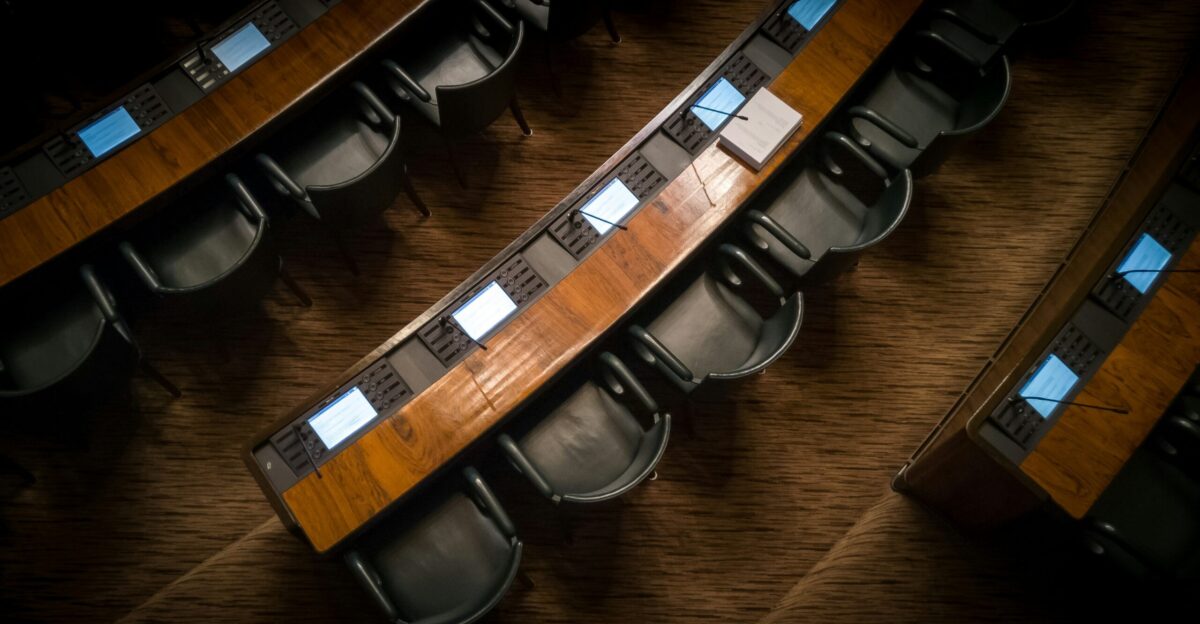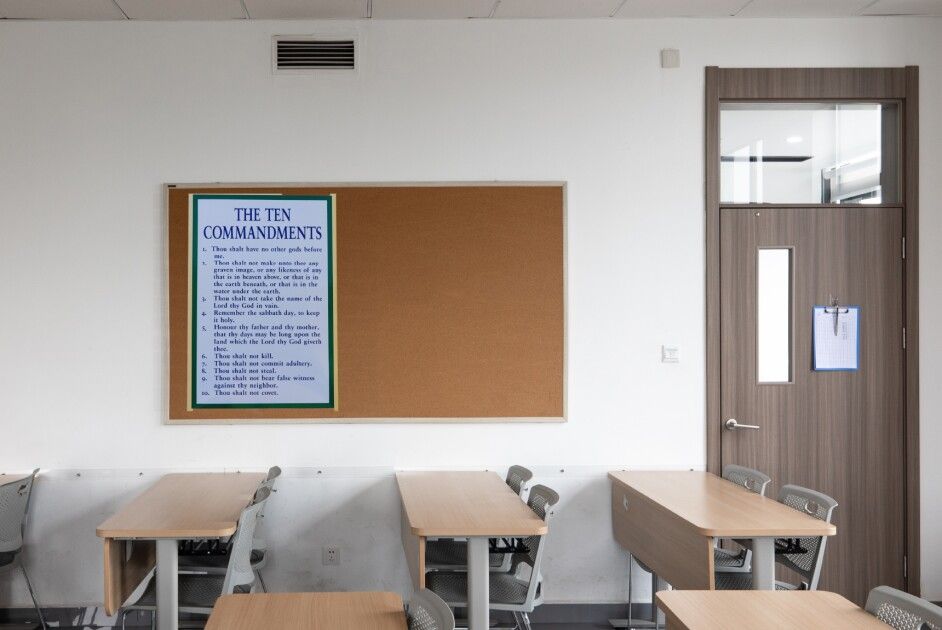
According to Texas’s 2025 law, a framed or poster version of the Ten Commandments, measuring at least 16 by 20 inches, must be prominently displayed in every public school classroom. Texas became the largest state to enforce this requirement on June 21, 2025, when Governor Greg Abbott signed Senate Bill 10 into law.
The law emphasizes uniformity and prohibits interpretive changes by excluding any additional text beyond the designated English version. Despite continuous discussions regarding the constitutional separation of church and state, this action is in line with a larger conservative trend to reinstate religious components in public education. Proponents contend that by giving students a clear ethical framework, this law fosters moral clarity in a time of perceived ethical relativism.
Legal Precedents and the Historical Context

Although the public display of the Ten Commandments in schools has been controversial, they have long influenced Western legal systems, including American jurisprudence. Many settlers’ Judeo-Christian ethical foundation was reflected in the commandments’ historical references in early American legal documents and moral instruction. But during the 20th century, religious symbols in public schools came under more and more legal scrutiny.
Opponents of Texas’s law point to Supreme Court decisions that prioritize church-state separation as evidence of this contentious heritage. Supporters, however, frame the exhibit as instructive rather than devotional, arguing that the commandments are a moral and cultural basis rather than a religious mandate. The difference between promoting religious doctrine and acknowledging historical influence is the crux of this argument.
Legislative and Political Dynamics

Deep ideological divisions within Texas politics and the country at large are reflected in the bill’s largely party-line passage. The legislation, which was supported by conservatives, passed the Texas Senate 20-11 and the House 82-46. It was sponsored by Republican Senator Phil King and supported by Representative Candy Noble.
This clause, which reflects a larger political strategy to assert conservative values in public institutions, signals the state’s commitment to vigorously defending the law. The passage of the bill is representative of the political environment in Texas, where conservative legislators are increasingly using education policy to further their religious and cultural agendas. Both proponents, who see the law as a return to moral order, and opponents, who see it as a threat to pluralism and a violation of religious freedom, have been energized by this dynamic.
Social and Psychological Consequences

By reinforcing a common moral framework, the Ten Commandments displayed in classrooms may encourage students to behave ethically and socially cohesively. According to psychological research, being exposed to unambiguous moral standards can affect pro-social conduct and deference to authority, which may lessen instances of violence, bullying, and cheating. The commandments’ explicit bans on stealing, killing, and lying are in line with generally acknowledged social mores, which could foster a sense of individual accountability and communal norms.
Proponents of the law contend that the universal principles of the commandments transcend particular religious doctrines and provide a unifying ethical foundation for education that can benefit all students, regardless of their beliefs. In increasingly pluralistic classrooms, this calls into question how to strike a balance between upholding diversity and advancing shared values.
Impact on Education and Integration of Curriculum

The Ten Commandments are required to be displayed but not taught in school, which calls into question their educational value versus their symbolic presence. Proponents argue that by providing a constant but passive ethical reference, conspicuous reminders of moral principles can gently influence student behavior and school culture without enforcing religious doctrine. This method is in contrast to secular civics education, which may combine historical context with moral education by emphasizing pluralistic values and critical thinking.
But without curriculum direction, the commandments run the risk of becoming merely ornamental, and there are lost chances to have deep conversations with students about history, ethics, and the law. Some educators are concerned that this could lead to tensions in the classroom or confuse the separation of church and state.
Legal Issues and Constitutional Discussion

The law was sued at the federal level almost immediately after it was passed by a variety of religious families and leaders, including representatives of the Nation of Islam and Christianity, who claimed it violated religious freedom and the Establishment Clause. Referencing recent decisions that invalidated comparable laws in Louisiana and Arkansas on constitutional grounds, legal experts forecast drawn-out court battles.
As a result, Texas law tests the bounds of religious expression in public institutions at a legal and cultural crossroads. Framing the commandments as moral and historical rather than religious is the foundation of the state’s defense; courts have occasionally accepted this tactic but have frequently rejected it. The resolution of these disputes will probably have an impact on national jurisprudence regarding religious displays in public schools, which could change the limits of the separation of church and state.
Wider Consequences

Some contend that by giving preference to one faith tradition in a diverse society, the inclusion of religious texts in public schools runs the risk of widening social gaps and eroding pluralism, in contrast to the prevailing conservative narrative. However, a counterargument contends that openly recognizing religious heritage could promote candid discussion of America’s nuanced cultural heritage and inspire students to critically examine the historical significance of religion in society and the law.
By requiring this discussion, Texas’s law may unintentionally spark a more thorough examination of religion’s place in public life that goes beyond simple symbolism. The law also pushes legislators and educators to reconsider how moral education can be provided in pluralistic environments without offending minority groups.
Religion as the Basis of Civic Life

Texas law can be viewed through a special lens that positions the Ten Commandments as a civic foundation similar to constitutional principles rather than as religious doctrine. This reinterpretation is consistent with historical accounts that link American legal customs to Judeo-Christian ethics, as demonstrated by the Founding Fathers’ writings and the impact of biblical law on early colonial charters.
By putting forth a hybrid model in which civic identity is informed by religious heritage without resorting to proselytizing, this approach questions the traditional secular-religious dichotomy. The idea that moral principles derived from spiritual traditions can be universalized as civic virtues prompts a reexamination of the relationship between ethical and legal education. Critics warn that this could lead to the exclusion of non-Christian viewpoints and blur the boundaries between church and state.
Possible Effects at the Second and Third Orders

If upheld, Texas’s law might encourage similar actions across the country, changing the moral climate of public education by normalizing religious symbolism in the classroom. Establishing clearer ethical standards could have an impact on community relations, school discipline procedures, and student behavior, possibly lowering certain types of misconduct.
The law also redraws the lines of church-state interaction in education by establishing a precedent for state participation in religious symbolism, which may spark discussions about other religious or philosophical displays. States may have to deal with higher administrative and litigation expenses. Politically, the law might inspire both opposition and conservative constituencies, impacting national education policy and election results.
Juggling Pluralism, Tradition, and the Law

A daring declaration of cultural heritage entwined with legal controversy is Texas’s requirement that the Ten Commandments be displayed in public school classrooms. Supporters contend that by giving students definite, tried-and-true moral principles, it reestablishes a moral compass that is fundamental to American identity and legal systems, potentially fostering social cohesion and promoting ethical education.
This law forces America to face how it reconciles its religious heritage with its dedication to secular governance, illuminating the continuous conflict between tradition and pluralism in a multicultural society. The final effect will be determined by court decisions, community reactions, and the application of education.






